Bulgaria
Bulgaria new 50-lev note (B238) confirmed introduced 01.11.2019
04 11, 2019 08:57 Category: Europe
According to a press release dated 18 October 2019, on 1 November 2019 the Bulgarian National Bank planned to introduce a new 50-lev note (B238) like the preceding issues, but with enhanced security features and tactile marks for the visually impaired.
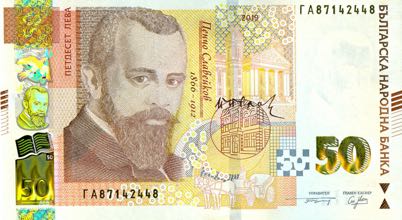
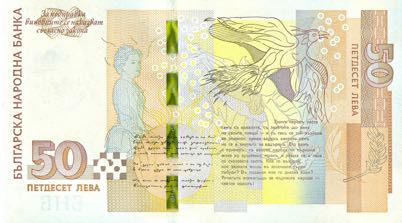
Courtesy of Andrian Chekanov, Robert Mol, and bgbgbg2008-2008 on eBay.


Courtesy of Andrian Chekanov, Robert Mol, and bgbgbg2008-2008 on eBay.
Bulgaria new 100-lev note confirmed introduced 28.12.2018
28 12, 2018 08:34 Category: Europe
This new 100-lev note is the first denomination in a new series the preceding issues, but with new security features, including the denomination in SPARK, a revised holographic stripe, improved watermark, and diagonal lines at left/right front as a tactile feature for the sight-impaired. Preceding issues will continue to circulate in parallel.
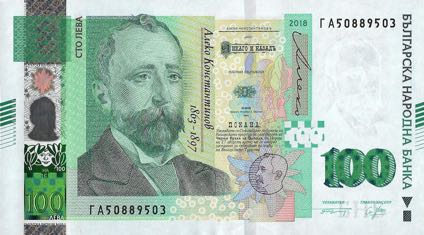

Courtesy of Krassy Dimitrov, Dimiter Monev, and Aditya Kulkarni.


Courtesy of Krassy Dimitrov, Dimiter Monev, and Aditya Kulkarni.
30% off select chapters of The Banknote Book in print
02 12, 2019 06:43 Category: The Banknote Book
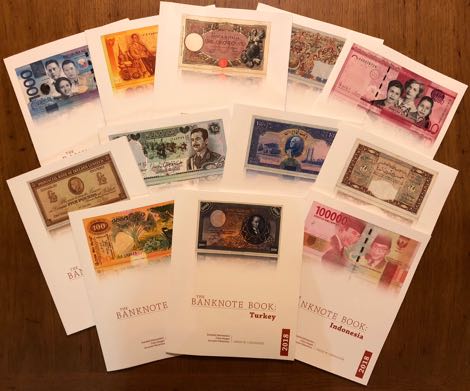
In response to customer demand, 26 of the largest chapters of The Banknote Book are now available in print.
The following chapters can now be ordered in print directly from Lulu.com or Amazon
Algeria
Argentina
Australia
Belgium
Bolivia
Bulgaria
Ceylon
Cuba
Dominican Republic
Egypt
Fiji
Germany
Indonesia
Iran
Iraq
Italy
Japan
Lebanon
Macau
Northern Ireland
Philippines
Romania
Syria
Thailand
Turkey
Venezuela
Prices range from US$24.99 to US$39.99, depending upon length, and all are professionally printed in full color on 80-pound glossy paper as perfect-bound paperback books.
Anyone purchasing from Lulu.com is entitled to a coupon code good for a free download of the PDF version of the chapter (US$9.99 value).
Use coupon code CYBERMONDAY30 when ordering on Lulu to get 15% off the list price for orders placed before midnight 3 December 2019.
Check Lulu's home page for discount codes on books and shipping.
Christoph Gärtner auction 35 takes place 19 October 2016 and is now online on Sixbid
13 09, 2016 15:39 Category: Miscellaneous
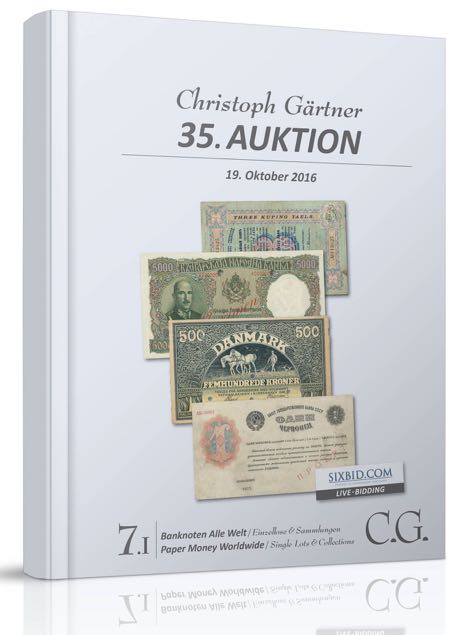
According to a press release, Christoph Gärtner auction 35 contains more than 3,000 banknote lots from all over the world, and all are now online on Sixbid.
Among them many rarities from Europe with rarely seen specimen banknotes including a comprehensive collection of Bulgaria will be offered.
"A special focus on banknotes from Russia and the Ukraine will be created by 1,400 different lots which will be offered as small collections and rare single notes. They start with the very early 18th century state issues, containing for example the very rare issue of 1,000-rubles 1895 P.A77, many specimen notes and nearly all issues of the “chervonetz”-series of the 1920s. The highlight of this section will be a prototype of a not issued project design of a 1-chervonets banknote from 1923. Furthermore a wide range of Russian regional and local issues will be auctioned, from North Russia to the far eastern regions – surely an exceptional collection of banknotes and an outstanding possibility to complete a collection.
But the auction will also show high value banknotes from Asia and Africa to complete this impressive offer of world banknotes which are waiting for your bids."
Bulgaria to replace 2-lev note with coin on 07.12.2015
30 10, 2015 09:26 Category: Europe
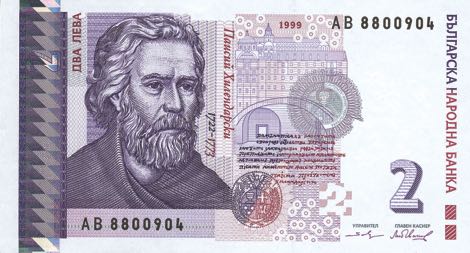
According to a press release dated 22 October 2015, the Bulgarian National Bank has announced that beginning 7 December 2015, its current 2-lev banknote (P115) will be replaced with a circulation bi-metallic coin of the same denomination. The existing 2-lev notes will remain legal tender circulating in parallel with the new coin.
Bulgaria 2-leva note to be replaced by coin in 2015
02 09, 2014 09:37 Category: Europe
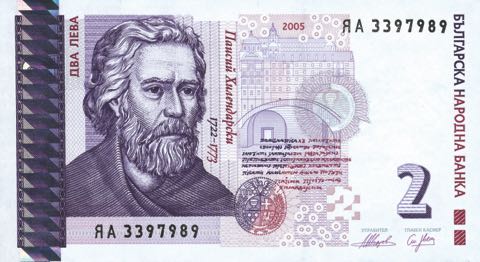
According to an article on Novinite.com dated 1 September 2014, the Bulgarian National Bank intends to replace the 2-leva banknote (P115) with a coin starting in 2015. The notes will remain legal tender, but will be withdrawn from circulation as they wear out.
Bulgaria 2-lev note likely to be replaced by coin
23 10, 2013 08:11 Category: Europe
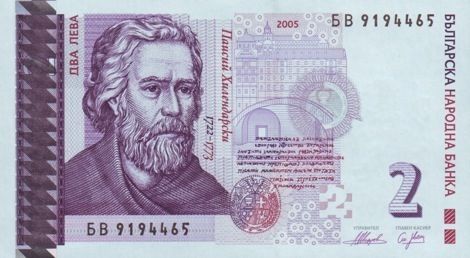
According to a Bulgarian National Bank press release dated 17 October 2013, "As a consequence of the specifics of the currency circulation and the rise in the price levels it is very likely that over the next years the banknote of BGN 2 [US$1.40; P115] would have to be replaced with a coin." Additionally the release indicates that the bank's note printing division and Francois-Charles Oberthur in France are finalizing a joint venture to fully utilize the former’s excess production capacity.
New holographic technology has designs on banknote security
06 07, 2010 09:03 Category: Miscellaneous
Technology continues to push the boundaries for banknote security holograms. Here, Dr Glenn Wood of the International Hologram Manufacturers Association looks at some of the latest developments.
Today, holographic technology remains very much to the fore as part of an array of overt features which make it quick and easy for people to recognise whether or not a banknote is bonafide. But new substrate technology, particularly the introduction of transparent ‘windows’ is being incorporated on banknotes to provide new levels of anti-counterfeiting complexity.
The commemorative 1,000 Tenge note produced by Papierfabrik Louisenthal for Kazakhstan and launched earlier this year takes optical sophistication to a new level. Not only does it feature a hologram showing typical rainbow colours but a small microlenticular patch viewed by transmission. The system is called Varifeye® and combines the best features of paper and polymer.

The optically variable feature on the new 1000 Tenge note of Kazakhstan showing microlenticular feature in the window and demetallised hologram below.
Previously, a deckle-edge window was created in the paper substrate during the process of cylinder-mould web formation as the stock fibers collect against the deckle, leading to the characteristic feather look. Latterly, the window has been cut into the paper after laminating to a polymeric layer. Then a clear stripe of film is laminated over it running from top to bottom of the note. The clear stripe contains the microlenticular image of a camel interchanging with the letter ‘K’ when tilted.
This feature can be viewed by transmission through the window. There is also a demetallised holographic image of the Astana Baiterek monument above the text ‘Organisation for Security & Co-operation in Europe’, interchanging with the date 2010 which are viewed by reflection where it falls over the paper. (This technology was first used on the Bulgarian lev banknotes in 2005, becoming the world’s first paper notes with see through window).
For polymeric substrates, the Bank of Australia has developed its Non-diffractive Switching Image (NSI). This appears like a dynamic watermark in the clear window of a polymer-based note. Being non-diffractive, the images are seen in varying shades of grey rather than rainbow colours and switching of the image elements occurs by rotation rather than tilting.
Mexico has also embraced new technology – the country’s 100 peso note has an ingenious feature which outwardly looks holographic but is in fact transparent optically variable inks (they are usually opaque) printed on the clear window of a polymer note. The viewer can look at the feature either by transmission or reflection. The inks change colour in both modes but the colours seen by transmission are the complementary colours of those seen by reflection.
The latest innovation in holographic technology which makes use of traditional (though modified) embossing technology is the Asterium feature from Toppan printing in Japan. Viewed in normal direct light this feature appears black but when inclined at an extreme angle, the rainbow colours of an embossed hologram appear. The important feature here is the optical black which gives a new aesthetic to documents and only reveals the colourful security feature as and when required.

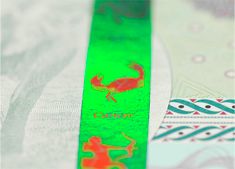
Asterium from Toppan uses optical black in conjunction with a hologram.
Another innovator, Kurz, has developed a revolutionary wafer thin security photopolymer which can record a volume holographic image for banknotes produced for Swiss National Bank. Kurz’s success has been to develop the material thin enough for use on a banknote, especially given that the reason this is called a ‘volume’ hologram is that the interference fringes are recorded within the depth of the photo-sensitive material. Similar developments are taking place in Japan where Dai Nippon Printing is leading the way.
OVD Kinegram, a division of Leonhard Kurz, continues to push the boundaries with its Kinegram reColor®. This has been developed for use as a laminate in conjunction with a window or aperture in the banknote substrate, and provides fundamentally different, and unexpected, effects depending on whether the note is viewed from the front or reverse. On the front the viewer sees a normal metallised reflective, diffractive image, while the reverse view shows a patterned coloured foil also displaying the diffractive features. The trick is performed using different coloured resist lacquers in the demetallization process. More remarkable still is Kinegram reView® which appears the same, metallic color on both sides of the image although the images seen on the two faces can be different and unrelated to each other.
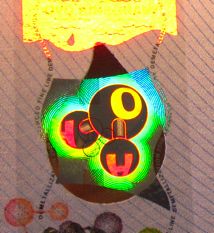
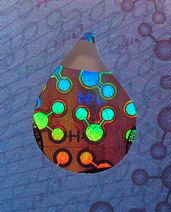
ReView from L. Kurz displays different holographic images when viewed from opposite side of a window.
One way or another, it seems that the window technology now becoming available to printers of banknotes is here to stay. Formerly, the opaque nature of security printing paper only allowed a watermark to be seen by transmission but most holograms are, by nature, transmissive and are rendered reflective by applying a metal coating. Once the opportunity is presented to allow them to be seen by transmission, as in a window, the opportunities for an optical tour de force are increased. This renders the note more visually attractive to inspectors and consumers and more difficult to simulate by counterfeiters.
However, here’s a cautionary word. Any trend towards simplification must be seen as a move in the right direction and run hand in hand with artists and graphic designers’ abilities to make good use of the media or of the public’s ability to appreciate and evaluate the security benefits offered by the latest technology. After all, it’s not as though holograms represent the only security feature on a banknote.
They are often one of many - for example, the 1000 Tenge note for Kazakhstan has at least 16 features including one to help the blind or partially sighted. So, it isn’t necessary to fill the hologram with every conceivable feature rather remember why the hologram was originally introduced: it provided a feature that could not be photocopied. Photopolymers provide this, so there’s no reason to suppose that holographic technology will not continue to be an integral security feature on future generations of banknotes.
END
The International Hologram Manufacturers Association (IHMA) is made up of 90 of the world's leading hologram companies. IHMA members are the leading producers and converters of holograms for banknote security, anti-counterfeiting, brand protection, packaging, graphics and other commercial applications around the world. IHMA member companies actively cooperate to maintain the highest professional, security and quality standards.
Issued on behalf of the IHMA by Mitchell Halton Watson Ltd. For further details contact Andy Bruce on +44 (0) 191 233 1300 or email andy@mhwpr.co.uk
Today, holographic technology remains very much to the fore as part of an array of overt features which make it quick and easy for people to recognise whether or not a banknote is bonafide. But new substrate technology, particularly the introduction of transparent ‘windows’ is being incorporated on banknotes to provide new levels of anti-counterfeiting complexity.
The commemorative 1,000 Tenge note produced by Papierfabrik Louisenthal for Kazakhstan and launched earlier this year takes optical sophistication to a new level. Not only does it feature a hologram showing typical rainbow colours but a small microlenticular patch viewed by transmission. The system is called Varifeye® and combines the best features of paper and polymer.

The optically variable feature on the new 1000 Tenge note of Kazakhstan showing microlenticular feature in the window and demetallised hologram below.
Previously, a deckle-edge window was created in the paper substrate during the process of cylinder-mould web formation as the stock fibers collect against the deckle, leading to the characteristic feather look. Latterly, the window has been cut into the paper after laminating to a polymeric layer. Then a clear stripe of film is laminated over it running from top to bottom of the note. The clear stripe contains the microlenticular image of a camel interchanging with the letter ‘K’ when tilted.
This feature can be viewed by transmission through the window. There is also a demetallised holographic image of the Astana Baiterek monument above the text ‘Organisation for Security & Co-operation in Europe’, interchanging with the date 2010 which are viewed by reflection where it falls over the paper. (This technology was first used on the Bulgarian lev banknotes in 2005, becoming the world’s first paper notes with see through window).
For polymeric substrates, the Bank of Australia has developed its Non-diffractive Switching Image (NSI). This appears like a dynamic watermark in the clear window of a polymer-based note. Being non-diffractive, the images are seen in varying shades of grey rather than rainbow colours and switching of the image elements occurs by rotation rather than tilting.
Mexico has also embraced new technology – the country’s 100 peso note has an ingenious feature which outwardly looks holographic but is in fact transparent optically variable inks (they are usually opaque) printed on the clear window of a polymer note. The viewer can look at the feature either by transmission or reflection. The inks change colour in both modes but the colours seen by transmission are the complementary colours of those seen by reflection.
The latest innovation in holographic technology which makes use of traditional (though modified) embossing technology is the Asterium feature from Toppan printing in Japan. Viewed in normal direct light this feature appears black but when inclined at an extreme angle, the rainbow colours of an embossed hologram appear. The important feature here is the optical black which gives a new aesthetic to documents and only reveals the colourful security feature as and when required.


Asterium from Toppan uses optical black in conjunction with a hologram.
Another innovator, Kurz, has developed a revolutionary wafer thin security photopolymer which can record a volume holographic image for banknotes produced for Swiss National Bank. Kurz’s success has been to develop the material thin enough for use on a banknote, especially given that the reason this is called a ‘volume’ hologram is that the interference fringes are recorded within the depth of the photo-sensitive material. Similar developments are taking place in Japan where Dai Nippon Printing is leading the way.
OVD Kinegram, a division of Leonhard Kurz, continues to push the boundaries with its Kinegram reColor®. This has been developed for use as a laminate in conjunction with a window or aperture in the banknote substrate, and provides fundamentally different, and unexpected, effects depending on whether the note is viewed from the front or reverse. On the front the viewer sees a normal metallised reflective, diffractive image, while the reverse view shows a patterned coloured foil also displaying the diffractive features. The trick is performed using different coloured resist lacquers in the demetallization process. More remarkable still is Kinegram reView® which appears the same, metallic color on both sides of the image although the images seen on the two faces can be different and unrelated to each other.


ReView from L. Kurz displays different holographic images when viewed from opposite side of a window.
One way or another, it seems that the window technology now becoming available to printers of banknotes is here to stay. Formerly, the opaque nature of security printing paper only allowed a watermark to be seen by transmission but most holograms are, by nature, transmissive and are rendered reflective by applying a metal coating. Once the opportunity is presented to allow them to be seen by transmission, as in a window, the opportunities for an optical tour de force are increased. This renders the note more visually attractive to inspectors and consumers and more difficult to simulate by counterfeiters.
However, here’s a cautionary word. Any trend towards simplification must be seen as a move in the right direction and run hand in hand with artists and graphic designers’ abilities to make good use of the media or of the public’s ability to appreciate and evaluate the security benefits offered by the latest technology. After all, it’s not as though holograms represent the only security feature on a banknote.
They are often one of many - for example, the 1000 Tenge note for Kazakhstan has at least 16 features including one to help the blind or partially sighted. So, it isn’t necessary to fill the hologram with every conceivable feature rather remember why the hologram was originally introduced: it provided a feature that could not be photocopied. Photopolymers provide this, so there’s no reason to suppose that holographic technology will not continue to be an integral security feature on future generations of banknotes.
END
The International Hologram Manufacturers Association (IHMA) is made up of 90 of the world's leading hologram companies. IHMA members are the leading producers and converters of holograms for banknote security, anti-counterfeiting, brand protection, packaging, graphics and other commercial applications around the world. IHMA member companies actively cooperate to maintain the highest professional, security and quality standards.
Issued on behalf of the IHMA by Mitchell Halton Watson Ltd. For further details contact Andy Bruce on +44 (0) 191 233 1300 or email andy@mhwpr.co.uk
Bulgaria issues revised 5-lev note
08 06, 2009 11:00 Category: Europe
On 1 June 2009, the Bulgarian National Bank introduced a revised BGN 5 banknote. The new 2009 issue has the same dimensions, coloring, and graphical design as the 1999 note, with some minor changes. Both notes will circulate in parallel. In keeping with a tradition which it started following the introduction of the 100-lev note issued 8 December 2003, the bank has sold the first 100 notes (serial numbers БА 0000001 to БА 0000100) for BGN 6.6 each, a 20% premium over face value.
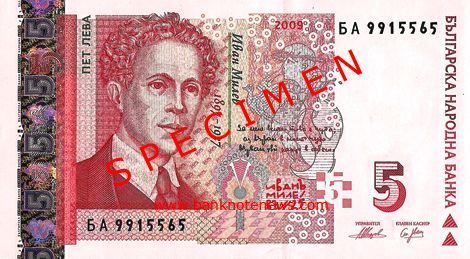

5 leva (US$3.55), 2009. Like Pick 116, but new date, new signatures, new holographic anti-copy stripe, new windowed security thread, added latent image, БНБ electrotype added to the watermark, and additional bifluorescence.
Courtesy of Krassimir Dimitrov, Andrew Roberts, and Stefan Tzvetkov.


5 leva (US$3.55), 2009. Like Pick 116, but new date, new signatures, new holographic anti-copy stripe, new windowed security thread, added latent image, БНБ electrotype added to the watermark, and additional bifluorescence.
Courtesy of Krassimir Dimitrov, Andrew Roberts, and Stefan Tzvetkov.
Bulgaria to issue new date (2008) 10-lev note
08 12, 2008 17:46 Category: Europe

On 8 December 2008, the Bulgarian National Bank (BNB) issued a revised 10-lev (US$6.50) note similar to the existing 1999 note (Pick 117), but with new date, signatures, and security features, including a red-to-green windowed security thread with demetalized text, watermark with electrotype bank initials, latent image, and UV elements.
Courtesy of Krassimir Dimitrov.
Bulgaria issues revised 20-lev note dated 2007
10 11, 2007 14:34 Category: Europe


20 lev (US$14.95), 2007. Issued 12.11.2007. Like P118, but new date, new signature (governor), windowed security thread, fluorescent image, and modified watermark.
Courtesy of Kevin Klauss.
Bulgaria's Cyrillic "evro" wins approval
18 10, 2007 10:51 Category: Europe
According to an 18 October 2007 Reuters report, “Bulgaria won the right to spell the euro common currency as ‘evro’ in its Cyrillic language…The EU newcomer has fought hard for the right to spell the euro according to Cyrillic rules despite the European Central Bank’s insistence that the euro be spelled the same way across the 27-nation bloc. The Black Sea country argued that ‘evro’ is the correct transliteration of ‘euro’ into Cyrillic…The question of whether Bulgaria will be able to use ‘evro’ on banknotes if it enters the single currency zone—something that is not expected until well after 2010—remains open.”
Bulgaria issues revised 50-lev note dated 2006
03 07, 2006 11:08 Category: Europe
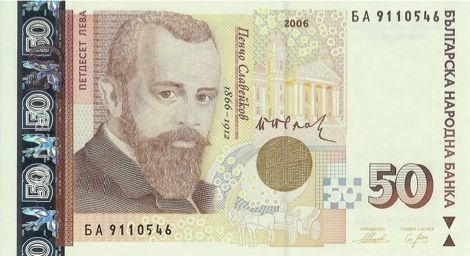

50 leva, 2006. Issued 03.07.2006. Like Pick 119, but series B, new signatures: Ivan Iskrov, Governor; Stefan Tzvetkov, Chief Cashier. New security features include latent image of “50” to the left of Pencho Slaveykov’s collar, golden to green OVI on National Library building under Slaveykov’s signature. Printer: BNB Printing Works, Bulgaria. 136 x 76 mm.
Courtesy of Chris Twining.
Bulgaria new date (2005) 2-lev note confirmed
13 03, 2007 17:39 Category: Europe

2 leva (US$1.35), 2005. Like Pick 115, but new date, new signatures, and series B. 116 x 64 mm.
For more information, visit the Bulgarian National Bank.
Courtesy of Menelaos Stamatelos, Southeastern Numismatics.
Bulgaria chapter of The Banknote Book is now available
17 04, 2019 08:30 Category: The Banknote Book | Europe
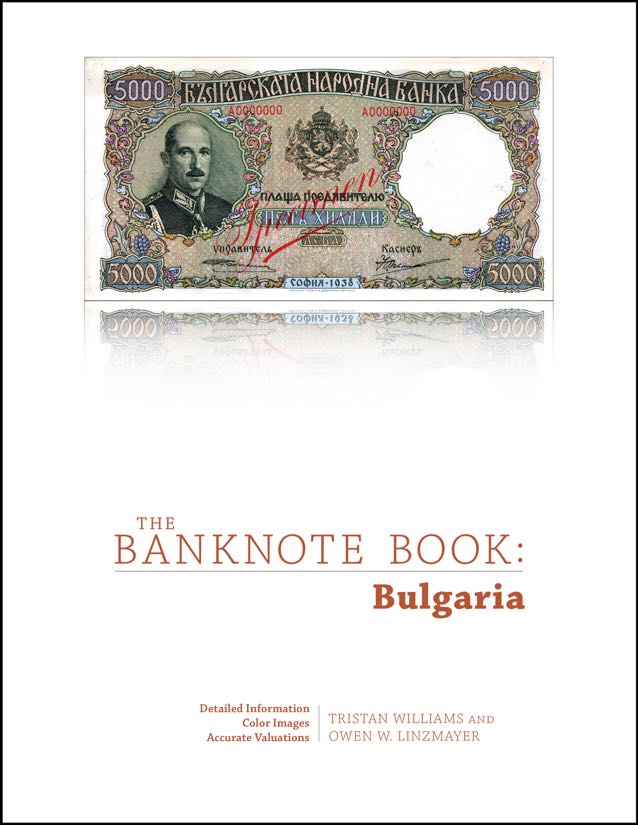
The Bulgaria chapter of The Banknote Book is now available for individual sale and as a free download to subscribers.
This 64-page catalog covers notes issued by the Bulgarian National Bank from 1885 to present, and the Thrace Interallied Administration in 1919. Published 19.04.2019.
Each chapter of The Banknote Book includes detailed descriptions and background information, full-color images, and accurate valuations. The Banknote Book also features:
- Sharp color images of note’s front and back without overlap
- Face value or date of demonetization if no longer legal tender
- Specific identification of all vignette elements
- Security features described in full
- Printer imprint reproduced exactly as on note
- Each date/signature variety assigned an individual letter
- Variety checkboxes for tracking your collection and want list
- Date reproduced exactly as on note
- Precise date of introduction noted when known
- Replacement note information
- Signature tables, often with names and terms of service
- Background information for historical and cultural context
- Details magnified to distinguish between note varieties
- Bibliographic sources listed for further research
Subscribe to The Banknote Book
If you collect the entire world or a large number of countries, buying a subscription is the best deal because it's less expensive than buying chapters individually, and it entitles you to every chapter currently available as well as everything published—or revised (click here to see the Change Log)—during the term of your subscription.

Sign up for Email Notifications
If you would like to receive email notifications whenever a new chapter of The Banknote Book is published, please join the email list by clicking the button below.


